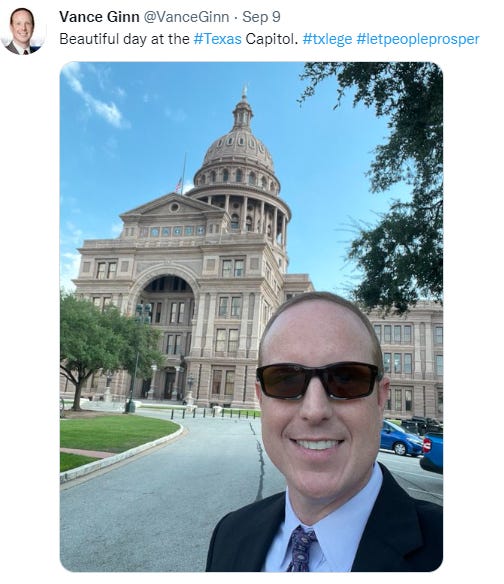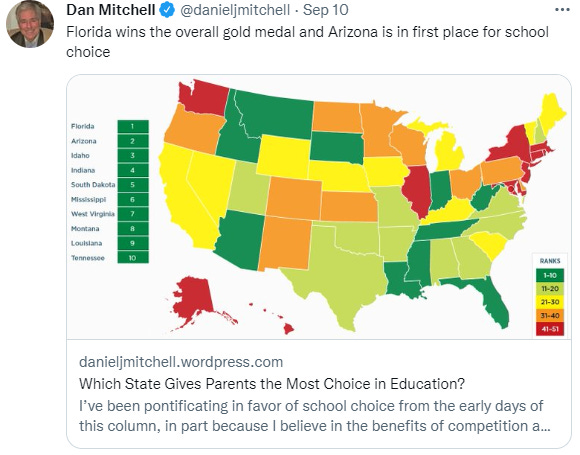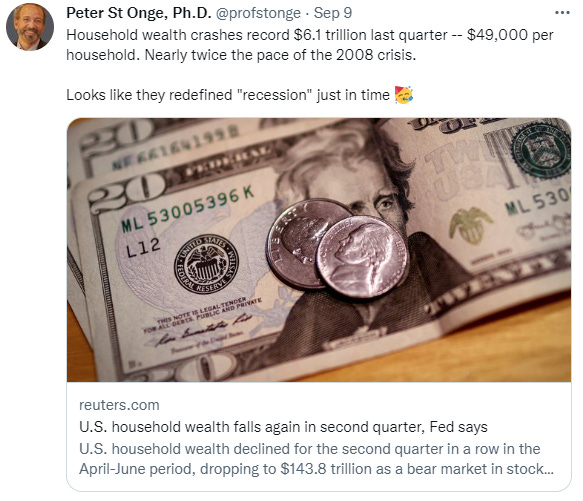82. Economic Freedom: Need Work Not Handouts for Prosperity
In this newsletter, I highlight the latest data on economic freedom of the world and note recent info on states, on poverty, on inflation, on economic opportunity, and more to let people prosper.
Hello Friend,
I hope you’re having a prosperous day! This newsletter will focus on the importance of economic freedom in the U.S., how the U.S. did in 2020 (latest data available), and how states compared in 2019 (latest data available), which I’m scheduled to present on this information at the Fraser Institute’s Economic Freedom of North America conference at SMU’s Bridwell Institute this week. I also provide insights on the recent CPI inflation data that remains red hot up 8.3% in August over a year ago, which remains the highest rate in 40 years. And I summarize and reflect on the Census Bureau’s reported income and poverty data for 2021.
In short, there is a need for more economic freedom so that there are more opportunities to gain dignity and income from work rather than dependency and handouts from safety nets. Let’s get to it!
HOT TAKE
The Economic Freedom of the World report recently showed that the U.S. fell from 6th to 7th place in 2020. There was a large decline in economic freedom that year due to the COVID-19-related shutdowns and other government interventions in the marketplace to the lowest rating since 2009 during the depths of the Great Recession.
Here’s an overview of economic freedom by quartile per country based on a number of key economic factors:
“The most recent comprehensive data available are from 2020. Hong Kong remains in the top position, though its rating fell an additional 0.28 points. Singapore, once again, comes in second. The next highest-scoring nations are Switzerland, New Zealand, Denmark, Australia, United States, Estonia, Mauritius, and Ireland.”
But even with the decline in economic freedom more broadly, there is a positive relationship between more economically free states and higher income per person.
The shutdowns certainly influenced the U.S. rating of economic freedom as it dropped in ranking by one place to 7th best overall but the rating is the lowest since 1975. This indicates the high costs of the shutdowns, government spending, high deficits, and other factors that destroyed many opportunities to prosper.
Given the continued deficit spending and increased regulations by Congress and the Biden administration in 2021, my guess is that the rating will likely be worse in next year’s report. These progressive policies are not only destroying economic freedom and individual liberty, but they are also destroying the American Dream. Hopefully, we can return to pro-growth policies ASAP.
Economic Freedom of North America 2021: From my commentary Economic Freedom lets Texans prosper
Texas Model of relatively less spending, no personal income tax, and sensible regulation continues to support improved economic freedom with more opportunities to flourish. But there’s room for improvement for the state recently ranked as the fourth most free nationwide.
Details: Canada’s Fraser Institute released the Economic Freedom of North America 2021 report last November that scores states for economic freedom based on government spending, taxation, and labor market regulation. Economic freedom essentially is the freedom for people to use their property with minimal government interference. These scores are based on the latest available data for all jurisdictions in 2019, so they don’t include the effects of the shutdowns yet but will in the next report later this year.
Based on these scores, they separate states into four quartiles. In the most-free quartile, the average per-capita income was 7.5% above the national average while the least-free quartile was 1% below it. Additionally, people tend to be richer when economic freedom is greater whereby people learn to fish.
Economic freedom is essential to human flourishing.
Texas was the most economically free state in 1981 when the first score was reported. This was when the state had more conservative Democrats before party realignment with a political trifecta—control of the governor, house, and senate. But that ranking fell as they started to impose big-government policies that lowered it to seventh in 1991. The Lone Star State then dropped further and bottomed out at ninth in 1993. Through the late 90s and early 2000s, the more progressive Democrat-controlled House continued to restrict economic freedom which kept our ranking stubbornly low.
The first Republican trifecta was in 2003. The new leadership helped weather the storm of a fiscal crisis during a severe recession by overcoming a $10 billion shortfall through spending restraint. This new direction for limited government helped improve the ranking to fourth in 2006, rising to as high as second in 2008, while falling to no lower than fifth since then. This is quite impressive given these rankings can move depending on the relative ranking of states, and other states attempted to follow what worked in Texas.
The stronger commitment to the more successful Texas Model in recent years with a more conservative Republican trifecta especially since 2015 has helped support more economic freedom and prosperity.
Comparatively, Texas’ economic freedom ranks considerably better than other large states like California’s 49th, which has ranked in the bottom five states since 2002, and New York’s 50th, which has been in the bottom three states since 1981. Texas trails New Hampshire, Tennessee, and Florida, but the state’s score of 7.75 is near the leaders. It is only 0.08 points behind the top-ranked New Hampshire and 0.03 behind third-ranked Florida.
This comparison indicates the difference in governing philosophy.
For example, more conservative Texas and Florida rank 13th and 6th best, respectively, in state and local spending per capita compared with progressive California and New York ranking 48th and last, respectively. Of course, lower spending means less taxation, as Texas and Florida rank fourth and eighth best, respectively, in state and local tax burden per capita, while California and New York rank 43rd and last, respectively.
And Texas and Florida are right-to-work states while California and New York are not. Texas continues to reduce barriers to work by removing unnecessary and harmful regulations, especially relating to occupational licensing—though there are still too many. And Texas keeps its minimum wage at the federal mandate of $7.25 per hour, though the real minimum wage is always $0.
These measures matter for human flourishing when you consider Texas has a lower cost of living (ranks 15th lowest in the state compared with Florida ranking 32nd, California 49th, and New York 48th) and better labor market outcomes, including lower income inequality and poverty.
Less economic freedom contributes to people fleeing California and New York for greener pastures. Over the last decade, the populations have grown more than two times faster in Texas and Florida compared with California and New York, and Texas’ population has grown 9.3% faster than Florida’s.
But Texas needs improvement.
One area is excessive local property taxes from too much government spending. The Texas Legislature provided limited relief this year, but much more is needed.
The state should build on its recent success of passing the strongest state spending limit in the nation this year by using use surplus funds to cut school district property taxes. And lawmakers should use the same approach for other local governments. These actions, along with redesigning the tax system, can result in eliminating property.
By continuing to build on past successes and remove government barriers, Texas can be the most economically free state to best let people prosper.
Institutions Matter: Reasons People Move From Blue to Red States (Updated version of 2021 version)
Institutions matter for the structure and change of societies and economies throughout human history. These institutions are not just economic institutions such as capitalism and socialism that can determine the allocation of resources, but also social institutions such as families, charities, and churches that can support the needy, and political institutions such as democracies and authoritarianism that determine property rights and enforce contracts.
Given that the system of federalism in the U.S. provides an opportunity for each state to devise different policies within a federal institutional framework of laws, fiscal policy, monetary policy, regulations, foreign trade policy, and other rules, this system provides a laboratory of competition among states to set their own institutional framework where all other factors are closer to remaining constant. This allows for an examination of each state’s economic results to determine which policies may support more prosperity than others. Demographics also play a part in states’ economic institutions and results; therefore, it is important to compare states that are as similar as possible to provide less biased comparisons, ceteris paribus.
The four largest states in terms of population and real (inflation-adjusted in chained 2012 dollars) private gross state product (GSP) in 2021 are California with 39.6 million residents and $2.5 trillion, Texas with 29.7 million residents and $1.6 trillion, Florida with 21.9 million residents and $872.2 million, and New York with 19.3 million residents and $1.3 trillion. The economic success of the Texas Model’s limited government framework demonstrates that institutions matter for prosperity. But Texas must improve to remain competitive and support greater flourishing.
How Has the Texas Model Performed Relative to Comparable States?
Note. Dates are for publication year or for the period’s average. Data shaded in red indicate “best” and in blue indicate “worst” per category by state.
Are Migrants Turning Texas Blue?
In a 2018 exit poll in the hard-fought U.S. Senate race between Sen. Ted Cruz (who had moved to Texas) and then-Rep. Beto O’Rourke (a Texas native), natives preferred O’Rourke by plus-3 points whereas movers favored Cruz by plus-15 points. Cruz won the race by 2.6 percentage points, meaning that if it were up to people who were Texans by birth, Cruz would have lost reelection.
The Texas Public Policy Foundation (TPPF) has conducted polls of registered voters to test attitudes between natives and non-natives. Its January 2020 poll of 800 registered voters found native Texans supported President Trump over Hillary Clinton by a 7-point margin compared to transplants, who supported Trump by a 12-point margin. TPPF’s polling found there was no statistical difference in voter preferences for either former President Trump or President Joe Biden in the 2020 election among natives versus non-natives. In both samples, support for the two candidates was balanced, with neither seeing an advantage. In the 2020 election, Trump received 52% of the vote while Biden received 46%, so TPPF’s polling sample slightly overrepresented Biden supporters while underrepresenting Trump supporters.
Conclusion
These data provide overwhelming evidence that the Texas Model of inclusive institutions with a relatively low tax-and-spend burden, no individual income tax, and sensible regulation provides an institutional framework supporting more job growth, higher wages, lower income inequality, and less poverty than in comparable states and the U.S., in most cases. Other states and D.C. would be wise to consider adopting Texas’s inclusive economic and political institutions that champion individual liberty, free enterprise, and personal responsibility. This is a path to providing an economic environment that allows entrepreneurs the greatest opportunity to thrive and for prosperity to be generated for the greatest number of people, especially the neediest among us.
Despite this success, improvements are needed to keep the Texas Model competitive and create even more opportunities for all to flourish. These improvements to Texas’s institutional framework include limiting the growth in government spending at all levels, eliminating the state’s onerous burdens of property and franchise taxes, reducing barriers to international trade, relieving people from burdensome occupational licenses, and reforming safety nets.
Even with these needed improvements, the historical data overwhelmingly show it has not been a miracle in Texas, but rather abundant prosperity generated by Texans from a proven institutional framework called the Texas Model.
[1] See Do Institutions Matter for Prosperity in Texas and Beyond? V. Ginn, Texas Public Policy Foundation, 2018 (https://www.texaspolicy.com/do-institutions-matter-for-prosperity-in-texas-and-beyond/).
TAKE ON STATE ECONOMIES & POLICIES
Don’t miss my latest commentary on the innovative, holistic approach called empowerment accounts to fight poverty that would help people achieve self-sufficiency.
Here’s a good reminder.
Texas has a lot of work to do for parents, students, and teachers when it comes to providing the many great benefits of school choice per the Heritage Foundation’s new rankings.
We’re missing some great opportunities to reform our drug laws and reform our immigration system to better let people prosper.
TAKE ON U.S. ECONOMY & POLICIES
New Census data indicate we have a growing dependency on government problem which isn’t supporting improved outlooks of self-sufficiency.
More on the costly effects of the shutdowns and progressive policies during the shutdowns that increased dependency on government and drove up price inflation, leaving many Americans worse off than before.
What is President Biden celebrating? Facts show people suffering.
At this pace, this will likely be the highest annual inflation rate since 1981 (I was born on November 12, 1981) when it was 10.4%.
The Fed remains well behind the curve to bring down inflation.
Many of President Biden’s priorities are screwed up compared with the reality that Americans are facing.
The national debt and associated higher interest rates and higher inflation are leading the U.S. down a dark fiscal path. Need a Responsible American Budget! See this entire post for more on the national debt.
Household wealth continues to decline during this terrible progressive policy era.
Remember when I wrote about the zombie economy in early June 2022? Well, zombie firms are growing.
PERSONAL TAKE
My family and I are continuing to live our dreams. My oldest son (8 years old) recently started practicing for the upcoming soccer season and he is a beast as a forward. My youngest son (4 years old) is continuing to push the envelope with us but in a good way as a middle child would. ha! And our baby girl (5 months old) continues to get bigger and sweeter every day. We’re truly blessed.
One of the things that I’ve been concerned about is how there seems to be a change in direction over time by some of those on the right away from the strong foundations of individual liberty and economic freedom and the high suspicion of government action and toward the use of government to achieve certain objectives too often driven by polls and politics than principles. This is something that we must watch because it would lead to worse outcomes.
I appreciated the opportunity to be on a panel during The State of Black Texas event at TPPF last week to talk about a more holistic approach to poverty relief.
If you haven’t heard my story yet, I hope you’ll listen to my testimony of how I got to where I am today in this recording that I did in 2018 about my life. I wasn’t able to include my time in the White House (June 2019-May 2020) and thereafter, but the key points in my journey was before then with much more to come. Please listen and subscribe (you can also find it on Spotify).
CLOSING TAKE
Economist Ludwig Von Mises had a way with words, and this one is so true and is a reason that economic freedom and individual liberty are the first priorities.
I’m praying that we will give our broken hearts to God who can heal all things. My word of the year has been “build.” But with my wife being sick during the late stages of pregnancy, the baby having colic, and my mom dying suddenly from end-stage liver disease, the first half of this year felt broken. But I can see the storm clouds parting and bright rays of sun shining through as God has big plans in store for the rest of the year. I’m already seeing this come to fruition as I started my own business, Ginn Economic Consulting, where I’m working on contract work with multiple think tanks in the liberty movement. God is good!
Thank you for reading and sharing this newsletter. Many blessings to you and yours!


































